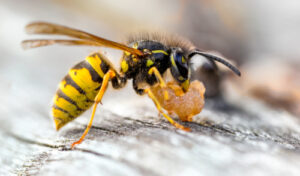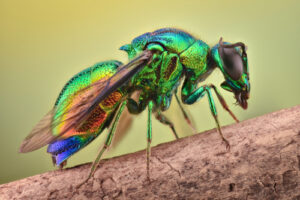The 10 Weirdest Facts About Wasps

Wasps are one of the many buzzing insects that might nest in or around your home or business this summer. While potentially terrifying due to their painful sting and vengeful nature, wasps are also fascinating insects.
Read our list of weird wasp facts to learn more about these hardy, intelligent and often maligned pollinators.
What Are Wasps?
Wasps are flying insects from the order Hymenoptera, suborder Apocrita, that are not ants or bees. They have narrow waists, wings and stingers. Common members include the European wasp and the yellowjacket. Wasps can feed on nectar or be predatory and attack other insects.
The many different types of wasps makes it difficult to generalize them. There is diversity and variety within each species.
Are Wasps Dangerous?
Wasps have a sharp stinger that injects a small dose of venom when they sting. They can sting multiple times, making them a bigger threat and more dangerous than bees. They are more aggressive than bees and will defend their nests against perceived threats.
Typically, a wasp sting will hurt for 1-2 hours. You may experience inflammation and redness at the location for a day or two. If you’re allergic to wasps, you may have a severe anaphylactic reaction that could cause labored breathing or possible death. Essentially, your body’s immune system overreacts to the sting and causes your body to swell up. This could result in constricted airways and the inability to breathe.
10 Wild and Weird Wasp Facts
Here are some quick and fascinating facts to help you better understand wasps and their role in our world:
1. The Only Wasp-Free Place on Earth is Antarctica
Wasps aren’t exclusive to your backyard or favorite park. There are some 30,000 species of wasps that live in nearly every part of the world. You’d have to go to Antarctica to avoid them for good.
2. Male Wasps are Good for One Thing
Non-queen female wasps serve a variety of roles from guarding the nest to feeding larvae. Male wasps, on the other hand, have a short and one-sided existence. A male wasp, also called a drone, exists only to mate with the queen. Once he’s succeeded, he will die – either due to damage sustained from the act or because he has nowhere to go. Males don’t even have a stinger to hunt or protect themselves.
3. Only The Queen Survives the Winter
By fall, you might notice that there are fewer wasps. As temperatures drop, social wasps leave their colony to die alone. Only young fertilized queens have the ability to hibernate. They find a sheltered location in a tree, underground or maybe in your home and reemerge in spring to single handedly restart the colony.
4. Wasp Venom Contains an Infectious Pheromone
If it’s ever felt like you angered one wasp and were suddenly the target of multiple wasps, you’re not imagining it. When wasps feel threatened, they release a pheromone that attracts other wasps and makes them more aggressive.
5. All Hornets are Wasps But Not All Wasps are Hornets
Hornets are a specific group of larger-sized wasps. The only true hornet in North America, ironically, is the European hornet. Wasp vs hornet distinction quickly becomes confusing when you consider that the bald-faced hornet, common in New York, is actually a type of yellow jacket wasp and not a true hornet.
6. Wasps Come in All Colors
You may only think of them as yellow and black but wasps come in every color imaginable. The Asian paper wasp is typically reddish-brown and amber. The blue mud wasp is a dark, smokey blue. The cuckoo wasp (pictured) has a bright blue or green sheen with a dark ruby abdomen.
7. Most Wasps are Solitary and Don’t Sting
We think of wasps as living in nests and flying out in buzzing hordes to terrorize the neighborhood, but that only describes a small fraction. Of the 30,000 species of wasps, 20,000 of them are solitary. They live in underground holes, sandbanks, cracks and crevices. They are less aggressive and few of them sting. Solitary wasps can be beneficial as they prey on other insects and spiders.
8. Wasps are Intelligent
Studies have shown that wasps can identify other wasps by their unique facial patterns. They can navigate accurately over several miles and have been shown to make logical inferences when confronted with the risk of electric shock.
9. Wasps Can Make Paper
Those papery nests that you see hanging from a tree or your home’s eaves are regurgitated wood or plant material mixed with wasp saliva. Wasps have strong jaws that allow them to scrape away wood from its source. They then use their saliva to break down the wood’s fibers until they’re a soft, pulpy consistency.
10. Many Wasps are Parasites
Many types of solitary wasps lay their eggs in the nests of other wasps or insects. When the larvae hatch, they feed upon the other insects and eventually kill them. Some wasps will paralyze prey like spiders or caterpillars and lay their eggs directly inside of them. The hatchlings awaken inside with a food source that cannot defend itself as they literally eat their way out.
Wasp Control in New York
Hopefully, you’ve gained new appreciation for the ways in which wasps survive. But, that doesn’t mean you have to like them crashing your BBQ. Don’t risk painful stings from these aggressive pests. Instead, call in the pros from Assured to identify and remove wasp nests around your home or business. Schedule your appointment today!

